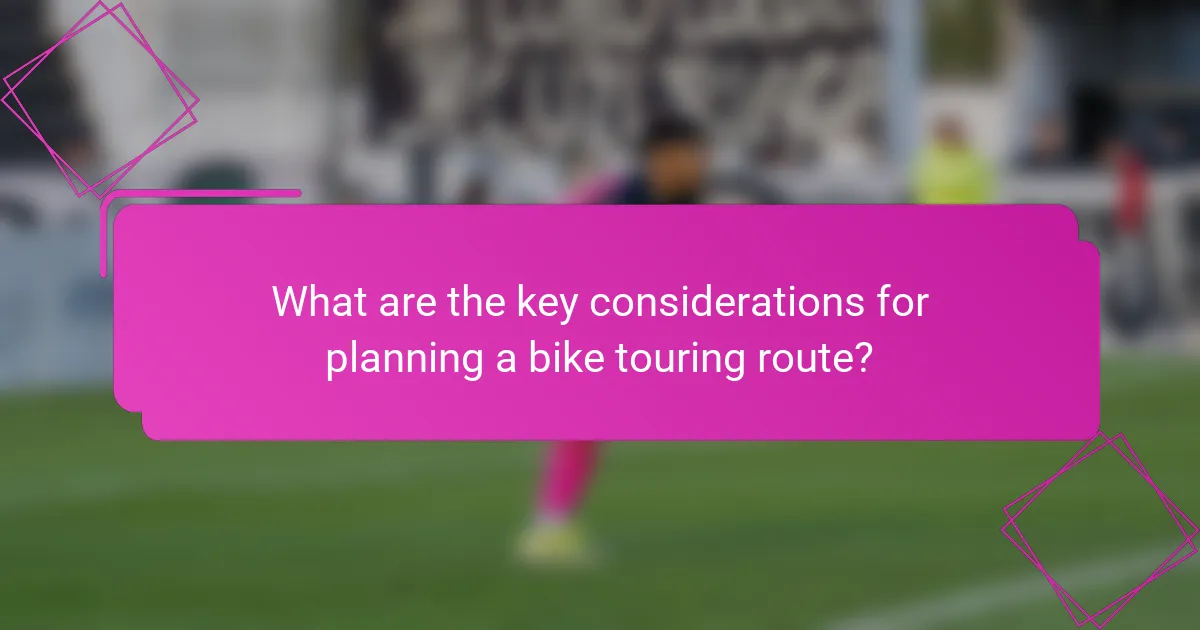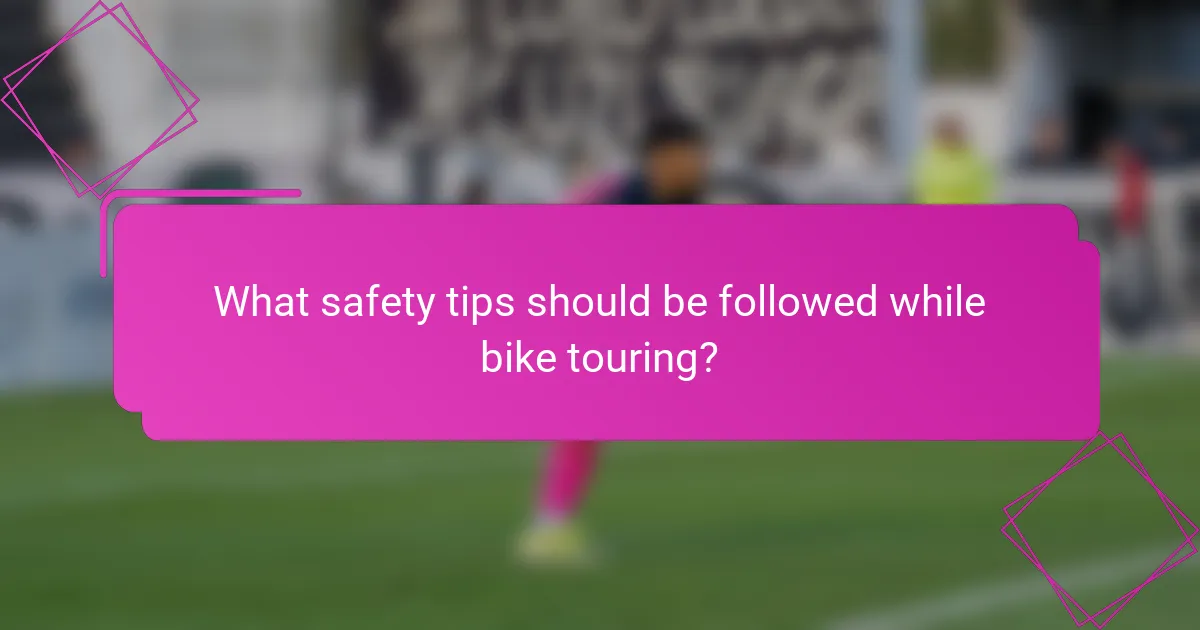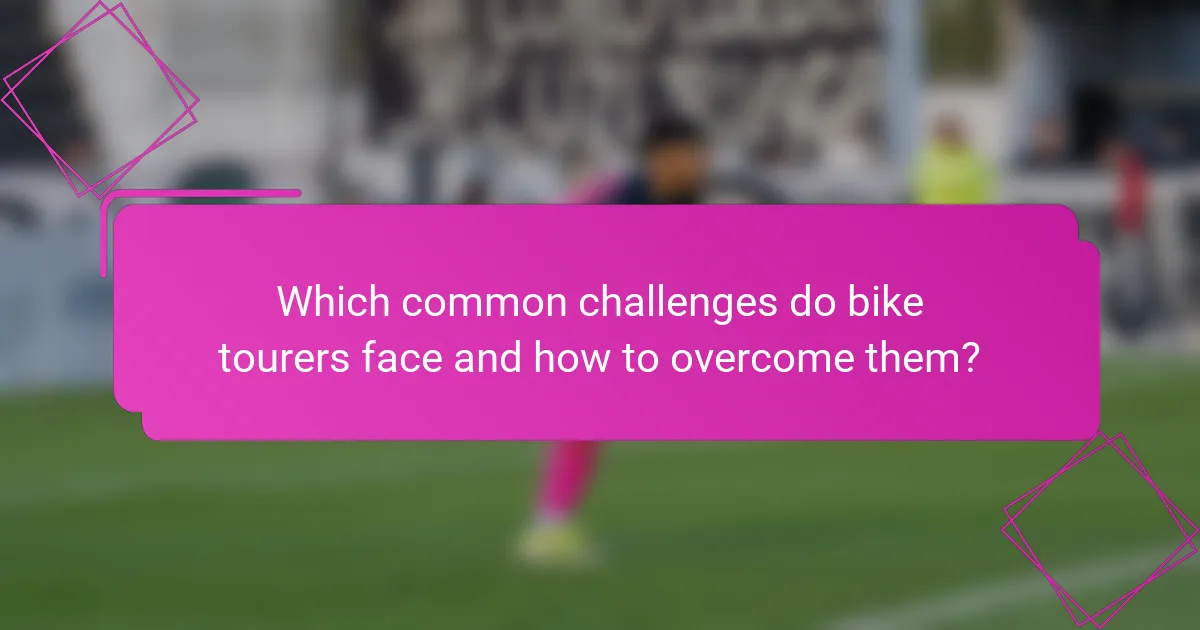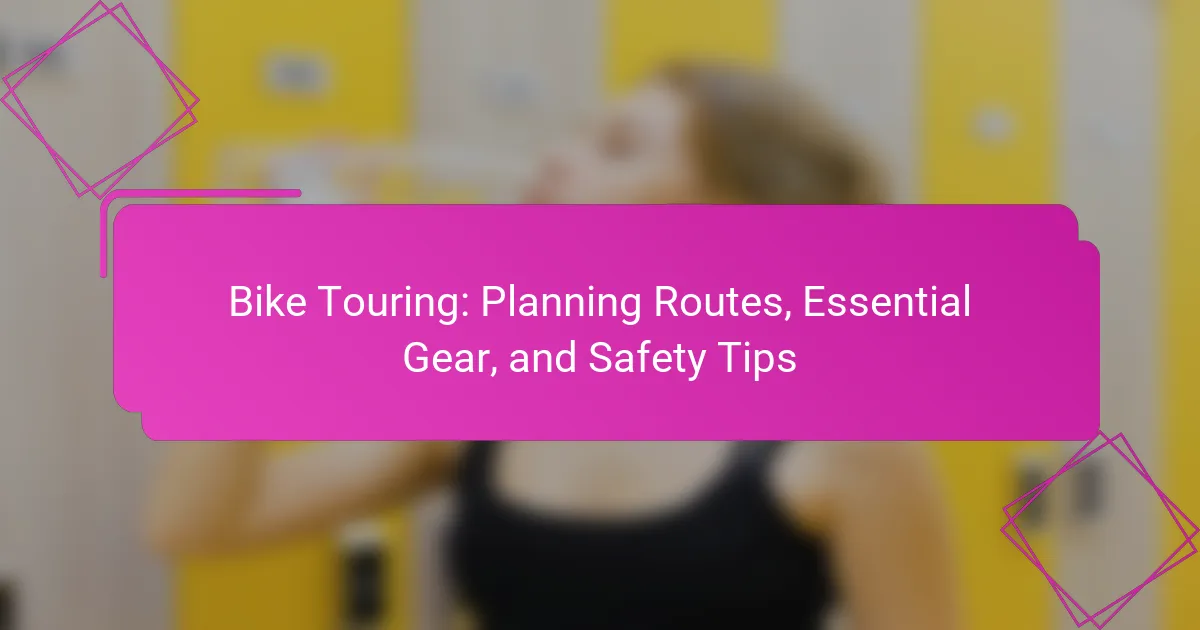Bike touring offers a rewarding way to explore new landscapes while enjoying physical activity. This guide covers planning routes based on terrain and distance, essential gear for comfort and safety, and crucial safety tips to enhance your experience. Learn how to navigate challenges, respect local customs, and maximize enjoyment on your journey. Prepare effectively to ensure a smooth and memorable bike touring adventure.

What are the key considerations for planning a bike touring route?
When planning a bike touring route, consider terrain, distance, weather, and accommodation options. Prioritize safety by researching road conditions and traffic. Include rest stops and local attractions for an enjoyable experience. Choose a route that matches your cycling skill level and physical endurance.
How do terrain and elevation impact route selection?
Terrain and elevation significantly influence route selection in bike touring. They determine the difficulty level, required gear, and overall travel time.
Steep elevations require more stamina and specialized gear, such as low gears and lightweight bikes. Flat terrains allow for faster travel and less physical strain.
Additionally, terrain types, like gravel or paved roads, affect tire selection and comfort. Routes with significant elevation changes may necessitate more frequent breaks for recovery.
Overall, understanding these factors ensures a safer and more enjoyable bike touring experience.
Which tools and apps are best for mapping bike tours?
The best tools and apps for mapping bike tours include Komoot, Ride with GPS, and Strava. These platforms offer user-friendly interfaces and detailed mapping features.
Komoot provides turn-by-turn navigation and offline maps, making it ideal for remote areas. Ride with GPS allows customization of routes and includes elevation profiles. Strava focuses on tracking and sharing rides with a strong community aspect.
Each tool caters to different needs, ensuring cyclists can find the right fit for their touring style.
What are the benefits of choosing scenic routes over direct paths?
Choosing scenic routes over direct paths enhances the bike touring experience by providing breathtaking views and unique encounters. Scenic routes often lead to less traffic, allowing for a more relaxed ride. They can also introduce riders to hidden gems, such as quaint towns and natural landmarks, enriching the journey. Additionally, these routes may offer varied terrains, improving physical fitness and making the ride more enjoyable. Exploring scenic paths encourages mindfulness and a deeper connection to nature, contributing to overall well-being during the tour.
How can local regulations affect your chosen route?
Local regulations can significantly impact your bike touring route by dictating permissible paths, safety requirements, and environmental protections. Understanding local laws ensures you choose routes that comply with traffic regulations and access restrictions. For example, some areas may require permits for certain trails or restrict cycling on specific roads. Additionally, regulations regarding helmet use, reflective gear, and night riding can vary, influencing your safety preparations. Always research local guidelines to enhance your touring experience and avoid potential fines.

What essential gear is required for a successful bike tour?
A successful bike tour requires essential gear to ensure comfort and safety. Key items include a reliable bike, helmet, repair kit, hydration system, and appropriate clothing.
1. Reliable bike: Choose a touring bike or a hybrid with a sturdy frame and comfortable geometry.
2. Helmet: Essential for safety, select one that fits well and meets safety standards.
3. Repair kit: Include tire levers, spare tubes, a multi-tool, and a pump for quick fixes.
4. Hydration system: Use a water bottle or hydration pack to stay hydrated during rides.
5. Appropriate clothing: Wear moisture-wicking layers, padded shorts, and weather-appropriate outerwear.
This gear ensures a smooth and enjoyable bike touring experience.
Which bike types are best suited for touring?
Hybrid bikes, touring bikes, and adventure bikes are best suited for touring. Each type offers unique features tailored for long-distance comfort and versatility.
Hybrid bikes combine road and mountain bike attributes, providing a comfortable riding position and wider tires for various terrains. Touring bikes are designed specifically for long-distance rides, featuring a stable geometry, multiple gear options, and the ability to carry heavy loads. Adventure bikes, often equipped for off-road capabilities, offer durability and versatility for mixed surfaces.
Selecting the right bike depends on your touring style, terrain, and gear-carrying needs.
What are the must-have accessories for comfort and safety?
Essential accessories for bike touring comfort and safety include a quality helmet, padded cycling shorts, and a reliable multi-tool. Additional items like a first-aid kit, water bottles, and a reflective vest enhance safety and hydration. A sturdy bike lock and panniers for gear storage improve convenience on long rides. Investing in these accessories ensures a safer and more enjoyable touring experience.
How does weather influence gear selection?
Weather significantly impacts gear selection for bike touring. Riders must consider temperature, precipitation, and wind conditions to choose appropriate clothing and equipment. For example, warm weather necessitates breathable fabrics, while cold conditions require insulation layers. Rain gear is essential in wet climates, and sturdy tires are crucial for windy routes. Adapting gear to the weather ensures comfort and safety during the journey.
What unique items should you consider for long-distance touring?
Consider unique items like portable solar chargers, multi-tool kits, and lightweight camping gear for long-distance touring. These items enhance convenience and safety on your journey. Portable solar chargers provide reliable power for devices, while multi-tool kits offer versatility for repairs. Lightweight camping gear minimizes bulk without sacrificing comfort.

What safety tips should be followed while bike touring?
To ensure a safe bike touring experience, follow these essential tips: wear a helmet, use lights and reflectors, obey traffic laws, stay aware of your surroundings, and maintain your bike regularly.
Always plan your route in advance and choose well-traveled roads or designated bike paths. Carry a first aid kit and familiarize yourself with basic repair techniques. Hydration and nutrition are crucial, so pack sufficient water and snacks.
Consider weather conditions and dress appropriately for changes in temperature. Lastly, communicate your itinerary to someone you trust for added safety.
How can you prepare for emergencies on the road?
To prepare for emergencies on the road during bike touring, ensure you have essential gear and a solid plan. Carry a first aid kit, multi-tool, spare tire, and a reliable map or GPS. Familiarize yourself with local emergency contacts and routes. Regularly check your bike’s condition to avoid breakdowns. Carry enough water and snacks to sustain energy during unforeseen delays.
What are the best practices for riding in traffic?
To ride safely in traffic, prioritize visibility, obey traffic laws, and maintain a safe distance from vehicles. Use hand signals to communicate intentions and wear a helmet.
1. Wear bright clothing and use lights to enhance visibility.
2. Follow all traffic signals and signs.
3. Maintain a safe distance from parked cars to avoid doorings.
4. Use bike lanes where available, but be cautious of merging vehicles.
5. Stay alert and anticipate the actions of drivers and pedestrians.
How do you ensure your bike is secure during stops?
To ensure your bike is secure during stops, use a high-quality lock and secure it to an immovable object. Always choose well-lit, busy areas for parking.
Consider using additional security measures such as wheel locks or alarms. Regularly inspect your lock for wear and replace it if necessary.

Which common challenges do bike tourers face and how to overcome them?
Bike tourers commonly face challenges such as navigation issues, weather conditions, physical fatigue, and gear malfunctions. To overcome these, plan routes with reliable maps, prepare for various weather scenarios, build endurance through training, and regularly maintain equipment.
What strategies can help with physical endurance during long rides?
To improve physical endurance during long rides, focus on hydration, nutrition, pacing, and rest. Staying hydrated prevents fatigue; aim for 500-1000 mL of water per hour. Consuming carbohydrates, such as energy gels or bars, replenishes energy stores. Maintain a steady pace to conserve energy over distance, and schedule regular breaks to recover. These strategies enhance overall performance and comfort during bike touring.
How do you manage nutrition and hydration on multi-day tours?
To manage nutrition and hydration on multi-day tours, prioritize balanced meals and regular water intake. Plan meals that include carbohydrates, proteins, and healthy fats. Carry lightweight snacks such as nuts and energy bars for quick refueling. Hydrate consistently, aiming for at least two liters of water daily, adjusting based on exertion and climate. Use portable filtration systems or purification tablets for reliable water sources.
What are the best ways to navigate unexpected weather changes?
To navigate unexpected weather changes while bike touring, prepare by checking forecasts regularly and carrying essential gear. Pack waterproof clothing, durable tires, and a reliable navigation system. Always have a flexible route plan and know safe shelter locations. Adjust your pace and hydration based on conditions to maintain safety and comfort.

What are the cultural considerations for bike touring in different regions?
Cultural considerations for bike touring vary significantly across regions. Understanding local customs, etiquette, and language enhances the experience and fosters respect.
In Europe, cyclists often encounter well-established bike lanes and a culture that embraces cycling as a primary mode of transport. In contrast, regions in Asia may have less infrastructure but offer rich cultural experiences.
In North America, safety is paramount; wearing helmets and following traffic laws is crucial. In some parts of Africa, engaging with local communities can provide insights into traditional practices and hospitality.
Overall, respecting local norms and being adaptable is essential for a rewarding bike touring experience.
How can local customs affect your touring experience?
Local customs can significantly enhance or complicate your bike touring experience. Understanding local traditions, etiquette, and regulations helps you navigate interactions and avoid misunderstandings. For example, greeting locals appropriately can foster goodwill, while disregarding customs may lead to negative encounters. Additionally, local food practices can influence your dietary options, impacting your energy levels during rides. Familiarizing yourself with these elements ensures a more enjoyable and respectful journey.
What are the best practices for interacting with locals during your tour?
To interact effectively with locals during your bike tour, prioritize respectful communication and cultural sensitivity. Engage with simple greetings in the local language to build rapport. Observe local customs and traditions, as this fosters goodwill. Ask open-ended questions to encourage conversation and learn about their way of life. Be mindful of personal space and body language, as these vary across cultures. Finally, express gratitude for their hospitality, which reinforces positive interactions.
How do different countries’ cycling infrastructure impact your trip?
Different countries’ cycling infrastructure significantly influences your trip’s safety, comfort, and enjoyment. Well-developed bike lanes and traffic regulations enhance the touring experience, while poor infrastructure can lead to hazards. For example, countries like the Netherlands offer extensive cycling paths, promoting a safer environment for cyclists. In contrast, regions with limited cycling facilities may require more caution and planning. Understanding these differences helps in route selection and gear preparation, ensuring a smoother journey.

What are the top tips for maximizing enjoyment during a bike tour?
To maximize enjoyment during a bike tour, focus on planning, preparation, and mindset. Choose scenic and safe routes that match your skill level. Invest in essential gear, including a comfortable bike, proper clothing, and navigation tools. Stay hydrated and fueled with nutritious snacks. Embrace flexibility in your schedule to explore unexpected sights and enjoy the journey.
How can you create a flexible itinerary that allows for spontaneity?
To create a flexible itinerary for bike touring, prioritize essential routes while allowing for unplanned stops. Start by mapping key destinations and attractions, then leave gaps for exploration. Incorporate local insights to discover hidden gems. Adjust your daily mileage to accommodate spontaneous detours. Carry lightweight gear to facilitate quick changes in plans.
What are the common mistakes to avoid while bike touring?
Common mistakes to avoid while bike touring include inadequate route planning, neglecting gear checks, and ignoring safety precautions.
Many cyclists underestimate the importance of mapping out routes in advance. This can lead to unexpected detours or difficult terrain. Additionally, failing to inspect essential gear, such as tires and brakes, can result in breakdowns. Riders often overlook the need for safety measures, including wearing helmets and having first aid kits.
Another frequent error is overpacking, which can make cycling uncomfortable and exhausting. It’s crucial to prioritize lightweight, necessary items to enhance the touring experience. Lastly, not staying hydrated can lead to fatigue and decreased performance, so regular water breaks are essential.
How can you document and share your bike touring experiences effectively?
To document and share your bike touring experiences effectively, use photos, journals, and social media. Capture daily highlights, route details, and gear insights. Organize your content thematically to engage your audience. Consider creating a blog or vlog for a comprehensive narrative.
